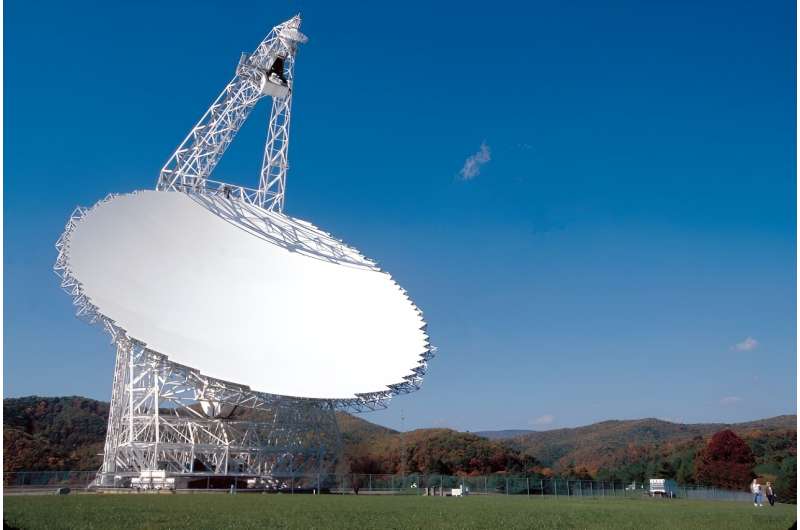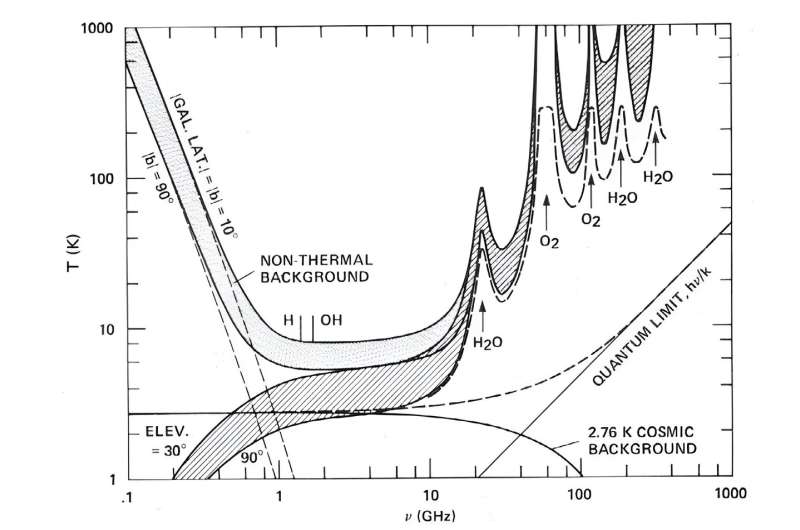This article has been reviewed according to Science X's editorial process and policies. Editors have highlighted the following attributes while ensuring the content's credibility:
fact-checked
preprint
trusted source
proofread
Astronomers scan 11,680 nearby stars for signals from advanced civilizations

The hunt for alien life and its radio signals from beyond our solar system is still coming up dry. But, it's not for lack of looking for possible advanced civilizations.
A recent search led by Jean-Luc Margot of UCLA's Earth, Planetary, & Space Sciences Department scanned stars within a few hundred light-years of Earth. Margot and his team looked for radio signatures of advanced civilizations in a sampling of "TESS Objects of Interest." TESS is the Transiting Exoplanet Survey Satellite doing an all-sky survey of nearby stars and their possible planets. The paper is published on the arXiv preprint server.
Margot is founder of UCLA SETI's "Are We Alone in the Universe?" project. It looks for evidence of other civilizations in the universe and pulls information from radio emissions that might identify them. From 2020 to 2023, Margot's team pointed the Green Bank Telescope toward the TESS objects to capture radio emissions coming from a specific region of space. The team used the L-band receiver on the scope, which scans a region of the spectrum between 1.15 and 1.73 GHz. That's a narrowband "window" where they suggest it might be possible to detect alien signals if they exist.
It would be exciting to find a "wow!" signal from another civilization. But, that didn't happen this time. The team wrote a paper detailing their work, and concluded, "Based on our observations, we found that there is a high probability (94.0%–98.7%) that fewer than ~0.014% of stars earlier than M8 within 100 pc host a transmitter that is detectable in our search." That's a rather definitive conclusion that nearby stars aren't sending cosmic "hello" greetings in our direction.
What would advanced civilizations use to communicate across space?
The hunt for extraterrestrial signatures from advanced civilizations is a relatively young science. The first searches began in the mid-20th century. Since then, SETI astronomers have figured out search strategies using available radio telescopes. But, it still faces some physical realities.
It's no surprise that communications across the gulfs of space are difficult. There's a time lag, of course. A signal we send to Proxima Centauri saying "Howdy" would take just over four years to get there at the speed of light. If anybody exists there, they'd sent a "Hi neighbor" back to us—again at the speed of light. Of course, it takes another four years or so to travel between us. That's eight years to establish a connection.
Consider also that signals have to pass through whatever "stuff" exists in space, like gas and dust. Those absorb some forms of radiation. However, radio signals get through pretty well, which makes them a good choice for an interstellar greeting. Next, you have to consider what frequencies to use. It turns out those between 1 and 10 GHz are quite useful because they avoid the galaxy's "hum" at lower frequencies. At higher frequencies, our own atmosphere (and probably those of other planets) can drown out any signals.
So, astronomers assume that another technologically advanced civilization might use that range, too. Of course, there are also language differences and cultural assumptions, which would shape any messages. But, at least having a frequency range helps get the hunt going.

What the team did
In their SETI search, Margot's team reasoned that they'd need to sample for emissions made by technologically savvy beings. They wrote, "The search for technosignatures provides an opportunity to obtain robust detections with unambiguous interpretations. An example of such a technosignature is a narrowband (say, <10 Hz at gigahertz frequencies) signal from an emitter located beyond the solar system. Detection of a signal with these characteristics would provide sufficient evidence for the existence of another civilization because natural settings cannot generate such signals."
In other words, they wanted to exclude natural emissions from the sample. Those would be radio signals created by naturally occurring events and objects. In our own solar system, for example, Jupiter has strong radio emissions. So does the sun, and Earth does, too, for that matter, but we can exclude those easily. Outside of the sun and planets, pulsars give off strong signals, as do star-forming regions, and supernova remnants. And, of course, there are very active emitters such as quasars and the regions around black holes. All of those sources have to be omitted from any surveys looking for techno-signatures.
So, the GBT captured emissions from around 11,680 stars and their planetary systems that lay between 5,385 and 18,173 light-years away. The observations occurred during two-hour sessions on April 22, 202, April 28, 2021, May 22, 2022, and May 13, 2023. They did two scans of about 2.5 minutes each on selected pairs of sources. Then, they processed the data, which included about 37 million narrowband detections of emissions. The resulting conclusion was that there are no advanced civilizations nearby that are transmitting in that range of frequencies.
Are we alone? Crowdsourcing the search
The search by Margot and his team also incorporates citizen scientists from around the world in a project called "Are We Alone in the Universe?" The collaboration has netted more than 300,000 classifications of radio signals in the nearby neighborhood sent in by more than 10,000 volunteers.
In addition, Margot offers a SETI course at UCLA for graduate students. The attendees learn to gather and analyze data from radio telescopes involved in the search. It's an eye-opening exploration of the different disciplines involved in the search for extraterrestrial intelligence. They include signal processing skills, data-gathering, telecommunications, statistics, and data science.
While the latest search for signals showed no evidence of technological civilizations in our near-Earth neighborhood, it does send an important message: if they're "out there" they are not in that sampling. As in so much of science, the lack of a conclusive signal is just as important as a conclusive one. For one thing, it researchers also need to distinguish between signals from space and signals from technology here on Earth. Sorting those out is an important part of any search paradigm.
The entire exercise also allowed the team to refine its pipelines of data and processing algorithms. That will be useful in the future if, and when, a signal is found that could indicate intelligent life out there. And, there is still a lot of sky to explore in the hunt for technologically advanced civilizations.
More information: Jean-Luc Margot et al, A Search for Technosignatures Around 11,680 Stars with the Green Bank Telescope at 1.15-1.73 GHz, arXiv (2023). DOI: 10.48550/arxiv.2308.02712
Journal information: arXiv
Provided by Universe Today



















